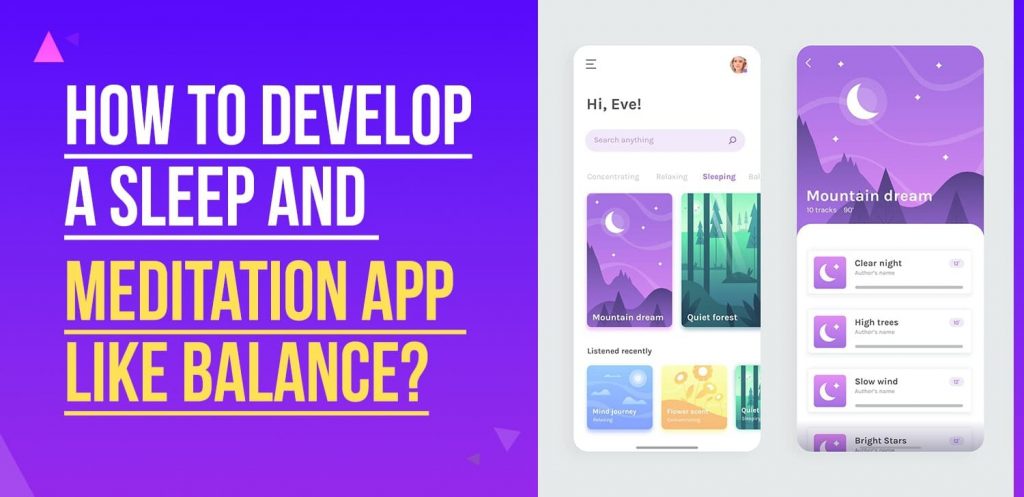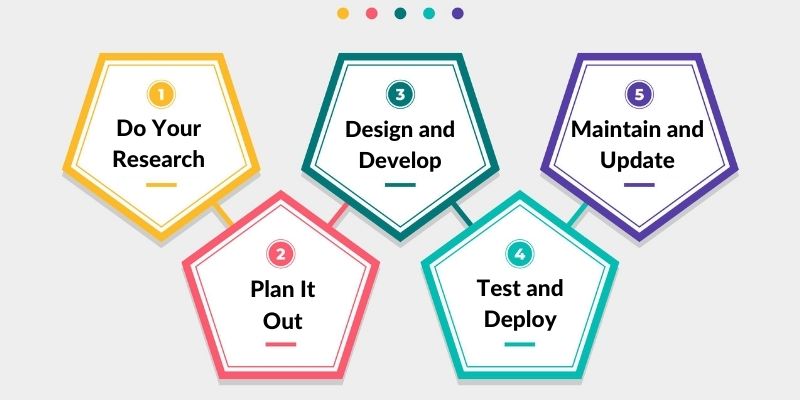
Meditation and sleep apps like Balance, Calm, etc., are a booming industry. Due to the growing numbers of anxiety and sleeping disorders patients globally, more and more people are moving away from traditional therapy and medications. They are now opting to use apps like Balance to help them remedy their ailments.
According to the Anxiety & Depression Association of America (ADAA), anxiety is the most common of all mental illnesses in the U.S., affecting 40 million adults (18 and older), making up for almost 18.1% of the population, every year. Furthermore, between 10%-30% of adults have insomnia, according to the CDC.
This paints a clear picture of a growing need for good meditation and sleep apps.
The mindfulness meditation apps market is set to hit the $4,377.95 mark by 2027. And aside from the heavyweights like Calm and Headspace, Balance, a relatively new player in the game, is helping drive this industry forward.
And if you want to learn how to develop meditation and sleep apps like Balance, we have a detailed guide to mindfulness and sleep care app development for you.
But before we move on, let’s talk a little about Balance and see what all the fuss is about.
Image Source
What Makes Balance So Unique?
Balance is all about providing its users with a personalized experience.
It understands what most apps don’t: meditation doesn’t adhere to the one-size-fits-all ideology.
Every person is different, and everyone is on their own journey, facing odds and adversities that can’t be put into neat little categories. Humans and human minds are complex, and so, Balance tries to create a personalized meditation experience for every user.
Balance offers a deep library of material like focus exercises, couples’ meditation, relaxation, sleep exercises, etc.
How Does Balance Work?
How Balance works can be explained in three simple points:
- Every day it asks you questions. These questions come from a vast pool of varying inquiries about your health, goals, and meditation experience.
Example: Are you stressed? How old are you? How do you feel? Have you meditated before? - Based on your answers to the above questions, Balance crafts a guided meditation program just for you. With the help of an audio library with thousands of files, it takes you on a meditation journey that has been custom designed for you and you alone.
- This is not a one-time process. Every day, you are asked new questions, and the more you share with your app, the better your meditation experience becomes.
How to Develop Sleep and Meditation Apps Like Balance?
Now that we know what Balance is and how it works, let’s learn how you can make an app like that of your own.
When it comes to app development, there are many routes you can take. You can develop this app on your own by hiring an in-house team. But this approach is best suited for companies and startups with deep pockets.

For budget startups, the better idea would be to hire a custom mobile app development company to develop their app for them. There are plenty of mobile app development companies in the market that offer reasonable rates. One of the most significant benefits of hiring a development firm is that you don’t have to bear the employee or infrastructure cost. With in-house development, you will be responsible for paying your employees, providing infrastructure such as a space to work, systems, internet, etc. All of this is a big undertaking, especially for startups.
However, whichever way you choose to go, this guide will be your faithful ally.
Step 1: Do Your Research
Research is the starting point of your development journey.
Without knowing the market, its pitfalls, lead players, and its customer base and type, you can’t expect to do well. The meditation and sleep app market is full of incredible apps that their customers love, and your goal is to get them to your app. So the first thing you need to figure out is what is it that they are doing that is being so loved by everybody?
In the case of Balance, that would be the app’s ability to provide personalized meditations to its users. But it can’t be just that one thing. Balance also has a lot of other features like Wind Down and Sleep that people love. So you need to figure out what your users want from apps like Calm, Headspace, Balance, etc.
Once you have all the necessary features down, you need to figure out what features these big apps are missing. There is always scope for innovation. Take Balance, for example. They realized that most of these apps were missing a touch of customization, and they made it available to the users.
That was their hook, and you need to find your app’s hook as well.
Other than competitor analysis, you will also need to know customer views for such apps. In the end, users make or break an app, and so their input is vital.
Study your competitors’ app pages on various app stores, see what their users are saying. Also, conduct surveys and face-to-face interviews with people. This information will be a gold mine for your app and will help you decide its direction.
It is also worth pointing out that apps like Balance need a professional’s touch, like a trained therapist or a neuroscientist—Someone who can help you come up with guided meditations, focus exercises, etc.
Step 2: Plan it Out
Once you have your research, it’s time to plan your development journey. Reading about developing an app and actually setting things in motion are two very different things. You will need to think of many things, starting from your revenue model to the choice of your platform and the area of your operations. You will also need to do all sorts of financial planning, from ROI to figuring out taxes and other such stuff.
From a development perspective, you will need to figure out the identity of your app. Why will the users be drawn to your app? What exactly does your app offer which the users can’t find anywhere else?
Once you answer these questions, you need to find out what type of app you want to develop.
There are two broad categories for mobile apps: native apps and cross-platform apps. Native apps are developed for one particular operating system and will not work on any other. So an app natively developed for Android won’t work on iOS. And if you want an app that is available on both Android and iOS, you will have to get them developed separately.
On the other hand, cross-platform apps run in web-browsers and require a stable internet connection to work, but their most significant benefit is that one app can run on as many operating systems as you like. While these apps are cheap since there is only one development cycle required, they lack the seamlessness and the visual appeal of native apps.
So if you are on a budget, then cross-platform apps are your best bet. But, a word of caution: having a cross-platform meditation app might not be a good idea. Since seamlessness and visual perfection are key selling points for such apps, the limitations of cross-platform app development might cause many problems.
You will also need to decide in this phase if you will go with in-house development or not. If you choose to hire a mobile app developer, you will need to do some more research.
There are a lot of great custom mobile app developers in the market that offer excellent services and charge reasonable rates. So figure out which developer can align with your needs and budget before hiring one. Also, find out their market reputation and what their previous clients have to say about their experiences with them.
Step 3: Design and Develop
One of the fundamental ingredients of mindfulness app development is the simplicity of design. People using such apps are already suffering from various mental and emotional challenges, and giving them a clunky UI with unnecessary graphics and oversaturated colors will only agitate them.
Apps like Calm and Balance thrive on soothing experiences and soft sounds. Nothing that triggers or overwhelms the senses should be used while designing the app. The color palette that you choose should be eye-soothing. Don’t think about blowing their minds away; think about healing them instead.
Another crucial part of meditation and sleep app development is user experience. Your app should be easy to use and navigate. The boxes and icons should be of appropriate sizes, and none of the key features should be buried deep in menus.
A good, soothing UI and a buttery smooth UX will instantly gain you a lot of points.
Now, the next thing is integrating the core system of your app. Like Balance, you will need a central system that can ask predetermined questions from a database in a randomized fashion and then use that data to pick the best-guided meditation recordings from your library. Such a level of sophistication requires a deft hand and years of experience to achieve, and so hiring an experienced mobile app developer is a good idea.
Most meditation apps use the tools the following tech stack:
Step 4: Test and Deploy
Once your app is ready, it’s time to test it for bugs and inconsistencies. This phase can take some time if the app is too complex or if there are too many problems.
Before releasing the app’s final version, companies often release their apps in early access or as beta versions. The reason behind it is information gathering and to see how the app behaves out in the wilderness. Early access and betas also create a buzz around the app, and if it’s good enough and famous enough, it can even attract some investors.
When all the bells and whistles are on, it’s time to deploy your app.
Step 5: Maintain and Update
After an app has been released, it needs to be monitored and patched for bugs. Furthermore, frequent updates for apps are also required. Mobile development doesn’t end with the release of the app. Over the years, you will need to tweak things and introduce new features, material, etc., to stay relevant.
Conclusion
Sleep and meditation apps are helping people across the globe live better lives and achieve their goals. Balance is just one of the apps working to help people improve their lives. And if you are looking for a development partner to help you make a meditation and sleep app like Balance, then Matellio has the experience and skills you require.
With decades of industry experience and a deep pool of varied talents, Matellio has helped businesses across the globe excel at their digitization journeys. Our flawless implementation of the Agile methodology helps us keep our clients in the loop and deliver high-quality products that exceed expectations. Our project managers are highly trained industry experts with valuable insights you can only acquire after years of hands-on experience.






